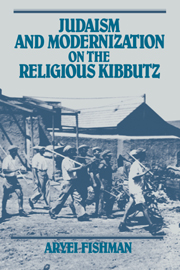Book contents
- Frontmatter
- Contents
- Preface
- Introduction
- PART ONE PROLOGUE
- 1 Conceptual and historical background
- PART TWO THE PARENT ORTHODOX MODERNIZING MOVEMENTS
- PART THREE THE RELIGIOUS KIBBUTZ MOVEMENT
- Afterword
- Appendix A The Religious Kibbutz Federation settlements
- Appendix B About the religious kibbutz members quoted in this book
- Appendix C Ideological periodicals referred to in book
- Notes
- Index
1 - Conceptual and historical background
Published online by Cambridge University Press: 29 October 2009
- Frontmatter
- Contents
- Preface
- Introduction
- PART ONE PROLOGUE
- 1 Conceptual and historical background
- PART TWO THE PARENT ORTHODOX MODERNIZING MOVEMENTS
- PART THREE THE RELIGIOUS KIBBUTZ MOVEMENT
- Afterword
- Appendix A The Religious Kibbutz Federation settlements
- Appendix B About the religious kibbutz members quoted in this book
- Appendix C Ideological periodicals referred to in book
- Notes
- Index
Summary
The goal of the pioneering communities established by the Religious Kibbutz Federation – to give “rebirth” to the Torah on a community level – involved a confrontation between two modes of religious charisma: an innovative religious consciousness, and institutionalized religious elements, especially elements of halakhah. In the words of a participant in the RKF experience, this was a confrontation between
two main aspirations latent in the premise of a pioneering religious movement: a dynamic, which impels towards active creation through a revolt against the accepted and the sacred, and spiritual submission, which demands the preservation of the extant, of the sacred in religious tradition.
By integrating modern ideological elements and traditional religion operationally, in the process of building its pioneering communities, the RKF sought to outstrip the rationalization of religion attained by the modernizing Orthodox movements that preceded it. And, indeed, the RKF kibbutzim seem to have reached the farthest inner limit of the rationalization process.
In this chapter, I shall explore the nature of religious charisma in general and the spontaneous charisma that was used in the RKF; survey traditional Jewish society and the changes that followed Emancipation; and set the scene for discussing the modern religious–ideological Orthodox movements that culminated in the RKF.
THE TRANSCENDENT CENTER AND CHARISMA
According to Edward Shils, the “vital layer of reality” in the transcendent sphere of human experience derives its vitality from the “center of the universe.”
- Type
- Chapter
- Information
- Judaism and Modernization on the Religious Kibbutz , pp. 9 - 28Publisher: Cambridge University PressPrint publication year: 1992



